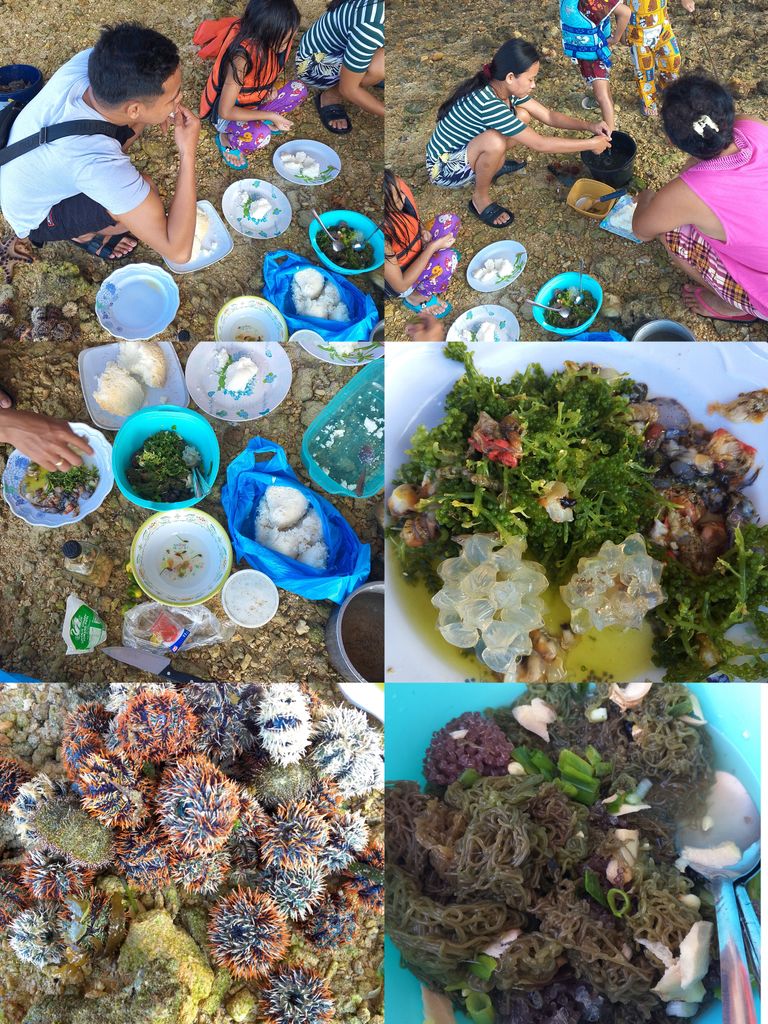Fresh Catch(mix seaweeds and seashells)

A seashell or sea shell, also known simply as a shell, is a hard, protective outer layer usually created by an animal or organism that lives in the sea. The shell is part of the body of the animal. Empty seashells are often found washed up oseashell is usually the exoskeleton of an invertebrate (an animal without a backbone), and is typically composed of calcium carbonate or chitin. Most shells that are found on beaches are the shells of marine mollusks, partly because these shells are usually made of calcium carbonate, and endure better than shells made of chitin.
Apart from mollusk shells, other shells that can be found on beaches are those of barnacles, horseshoe crabs and brachiopods. Marine annelid worms in the family Serpulidae create shells which are tubes made of calcium carbonate cemented onto other surfaces. The shells of sea urchins are called "tests", and the moulted shells of crabs and lobsters are exuviae. While most seashells are external, some cephalopods have internal shells.
Seashells have been used by humans for many different purposes throughout history and prehistory. However, seashells are not the only kind of shells; in various habitats, there are shells from freshwater animals such as freshwater mussels and freshwater snails, and shells of land snails.n beaches by beachcombers. The shells are empty because the animal has died and the soft parts have decomposed or been eaten by another animal.
Seaweed" is the common name for countless species of marine plants and algae that grow in the ocean as well as in rivers, lakes, and other water bodies.
Some seaweeds are microscopic, such as the phytoplankton that live suspended in the water column and provide the base for most marine food chains. Some are enormous, like the giant kelp that grow in abundant “forests” and tower like underwater redwoods from their roots at the bottom of the sea. Most are medium-sized, come in colors of red, green, brown, and black, and randomly wash up on beaches and shorelines just about everywhere.
The vernacular “seaweed” is a bona-fide misnomer, because a weed is a plant that spreads so profusely it can harm the habitat where it takes hold. (Consider kudzu, the infamous “mile-a-minute vine” that chokes waterways throughout the U.S. Southeast). Not only are the fixed and free-floating “weeds” of the sea utterly essential to innumerable marine creatures, both as food and as habitat, they also provide many benefits to land-dwellers, notably those of the human variety.
Seaweed is chock-full of vitamins, minerals, and fiber, and can be tasty. For at least 1,500 years, the Japanese have enrobed a mixture of raw fish, sticky rice, and other ingredients in a seaweed called nori. The delectable result is a sushi roll.
Many seaweeds contain anti-inflammatory and anti-microbial agents. Their known medicinal effects have been legion for thousands of years; the ancient Romans used them to treat wounds, burns, and rashes. Anecdotal evidence also suggests that the ancient Egyptians may have used them as a treatment for breast cancer.
Certain seaweeds do, in fact, possess powerful cancer-fighting agents that researchers hope will eventually prove effective in the treatment of malignant tumors and leukemia in people. While dietary soy was long credited for the low rate of cancer in Japan, this indicator of robust health is now attributed to dietary seaweed.
These versatile marine plants and algae have also contributed to economic growth. Among their many uses in manufacturing, they are effective binding agents (emulsifiers) in such commercial goods as toothpaste and fruit jelly, and popular softeners (emollients) in organic cosmetics and skin-care products.
*Have A Wonderful Friday To All Of Us!🤗😍
THANK YOU FOR ALWAYS SUPPORTING MY BLOGS!💖🥰
Congratulations, your post has been curated by @dsc-r2cornell. Also, find us on Discord
Felicitaciones, su publication ha sido votado por @dsc-r2cornell. También, encuéntranos en Discord